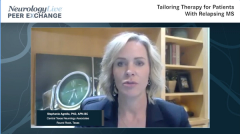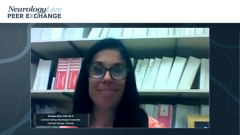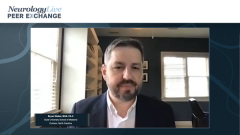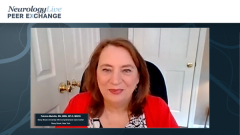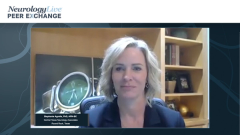
Revised Recommendations for Diagnosing Relapsing MS
An overview of revisions to the McDonald criteria used to help diagnose relapsing multiple sclerosis, and recommendations to follow when referring to criteria and imaging results when evaluating patients.
Episodes in this series

Transcript:
Amy Perrin Ross, APN, MSN, CNRN, MSCN: Welcome everybody to this edition of NeurologyLive® Peer Exchange® titled, “Optimal Management of Relapsing Multiple Sclerosis: Advanced Practice Providers’ Perspectives.” I am Amy Perrin Ross, an advanced practice consultant nurse from the Chicago area; and joining me today in this virtual discussion are a number of my colleagues from around the country. First we have Dr Stephanie Agrella from Central Texas Neurology Associates, in Round Rock, Texas; Dr Christen Kutz from Colorado Springs Neurological Associates, in Colorado Springs, Colorado; Patricia Melville from Stony Brook University MS Comprehensive Care Center in Stony Brook, New York; and Bryan Walker from Duke University School of Medicine, Department of Neurology, Durham, North Carolina. Today, we’re going to discuss several topics pertaining to the diagnosis and treatment of multiple sclerosis [MS]. Let’s get started with our first topic, which is an overview and first-line therapies for relapsing MS. I’ll ask Bryan first to please provide a brief overview of the McDonald criteria for the diagnosis of MS.
Bryan Walker, MHS, PA-C: Thanks, Amy. I believe that most of us are used to working with the McDonald criteria for making the diagnosis of MS over the course of our careers. And as things develop and as our technologies develop, we’re able to refine that diagnosis criteria. And this has gone under a few revisions over the years, but most recently in 2017, the revised McDonald criteria were published in The Lancet journal. What this basically helps us do is work to define what is MS and what’s not MS, particularly relapsing forms of MS. In the past, we’ve had different forms of MS that we’ve tried to classify patients into, clinically isolated syndrome, radiographically isolated syndrome, clinically definite MS, relapsing forms of MS, and progressive forms of MS. What the revised criteria have done is help us make the diagnosis earlier and more succinctly in order for us to get patients on medication therapy as soon as possible. But we know over time that it’s been shown, the sooner we can get patients on highly effective medication, we’re better able to change the trajectory of the course of their disease. Hopefully that’s the case.
The revisions in the 2017 McDonald criteria revolve around the issues of dissemination in space and time, which are the 2 major criteria that we’re trying to define when we’re trying to diagnose multiple sclerosis. The way that the revised criteria shape out is that if a patient has 2 or more clinical attacks, and 2 or more lesions with objective clinical evidence, we don’t need any more additional data to make the diagnosis. We can make the diagnosis of multiple sclerosis at that time. If they’ve had 2 or more clinical attacks but 1 lesion with clinical objective evidence, then again, we don’t need additional data. We can make the diagnosis fairly firmly that they had multiple sclerosis. If the patient has 2 or more clinical attacks but only 1 lesion with some clinical evidence that this is consistent with that clinical attack, we’ve shown dissemination in time, but what we need to prove is dissemination in space. We would need to show an additional clinical attack implicating a different site within the central nervous system on MRIscan. Now if a patient has only 1 clinical attack, however, they have 2 or more of these objective lesions with evidence, then we’ve shown dissemination in space, but not dissemination in time. We would need to prove that.
And if they only have 1 clinical attack, and say 1 lesion with clinical evidence, we would need to still promote dissemination in space and dissemination in time. What this has done is helped us, again, make the diagnosis a little bit earlier. Some of that additional information could be obtained within the CSF [cerebrospinal fluid] with oligoclonal banding; and we’ll look to do a lumbar puncture [LP] for spinal fluid evaluation at that time if we’re still trying to make that diagnosis. It’s been helpful for us to make that diagnosis sooner. And I’d love to hear if any of our other colleagues on our panel today have had either good success with using this, if it’s made their life easier, or if there’s still some confusion around that.
Patricia Melville, RN, MSN, NP-C, MSCN: I’ll just say, Bryan, that in our center, we do LPs regularly for our patients. The inclusion of the oligoclonal bands, which had been taken away from one of the prior iterations of the McDonald criteria, we’re very happy to see that put back in again; and that helps us with guiding the diagnosis.
Amy Perrin Ross, APN, MSN, CNRN, MSCN: In my practice, Bryan, the addition of MRI for dissemination in space and dissemination in time has been particularly helpful because particularly in a tertiary center like ours, if you’re seeing patients for a second opinion, or sometimes even a third opinion, it may have been a year since their first attack, if you will; and they lose a lot of the details. And so if they’re not able to paint a really clear picture, we really rely on what we’re seeing on MRI; and especially if they have previous MRIs that we can compare our current MRI to. When we get a new patient in our practice, we want to reconfirm the diagnosis each time because some of the stuff that we get is quite interesting. Even in my practice, looking back 25, 30 years ago, when we had diagnosed people who are still with us, we were diagnosing them sometimes pre-MRI, sometimes with the half Tesla MRI; and what we saw back then looked amazing. But when we look at it now, we say to ourselves, “What were we thinking?” We go back periodically and just reconfirm. And the McDonald criteria have been incredibly helpful for us in doing that.
Bryan Walker, MHS, PA-C: That’s great. And certainly, there tends to be some confusion around the use of optic neuritis as well. And with this current criteria, the focus on the optic nerve is a little bit challenging and can be a bit confusing. Hopefully, we’ll get more refinement with additional iterations of this, and as we look toward biomarkers in the future.
Amy Perrin Ross, APN, MSN, CNRN, MSCN: That sounds good. You mentioned biomarkers. And I’d like to ask Pat what she thinks about biomarkers and how she’s utilizing the CSF results in her practice.
Patricia Melville, RN, MSN, NP-C, MSCN: I can’t wait for biomarkers to be mainstream. At this point, it’s very limited. Certainly, looking at oligoclonal bands, there may be some prognostic indicators for that. At this point, NfL [neurofilament light chain] is still in its infancy, it’s not quite ready for prime time. But hopefully, as time goes on, we’ll gain more biomarkers because the more information we have, the more helpful it’s going to be for us in terms of recommending treatment and being able to predict patients’ responses to treatments.
Amy Perrin Ross, APN, MSN, CNRN, MSCN: Thank you all so much. I would like to thank this wonderful panel, Christen Kutz, Stephanie Agrella, Bryan Walker, and Patricia Melville, for this wonderful discussion. I’d like to thank you as an audience for watching NeurologyLive® Peer Exchange. If you enjoyed the content, I would suggest that you subscribe to the NeurologyLive® newsletters to receive information about upcoming Peer Exchanges and other content available to you. Thank you all so much.
Transcript edited for clarity.
Newsletter
Keep your finger on the pulse of neurology—subscribe to NeurologyLive for expert interviews, new data, and breakthrough treatment updates.

